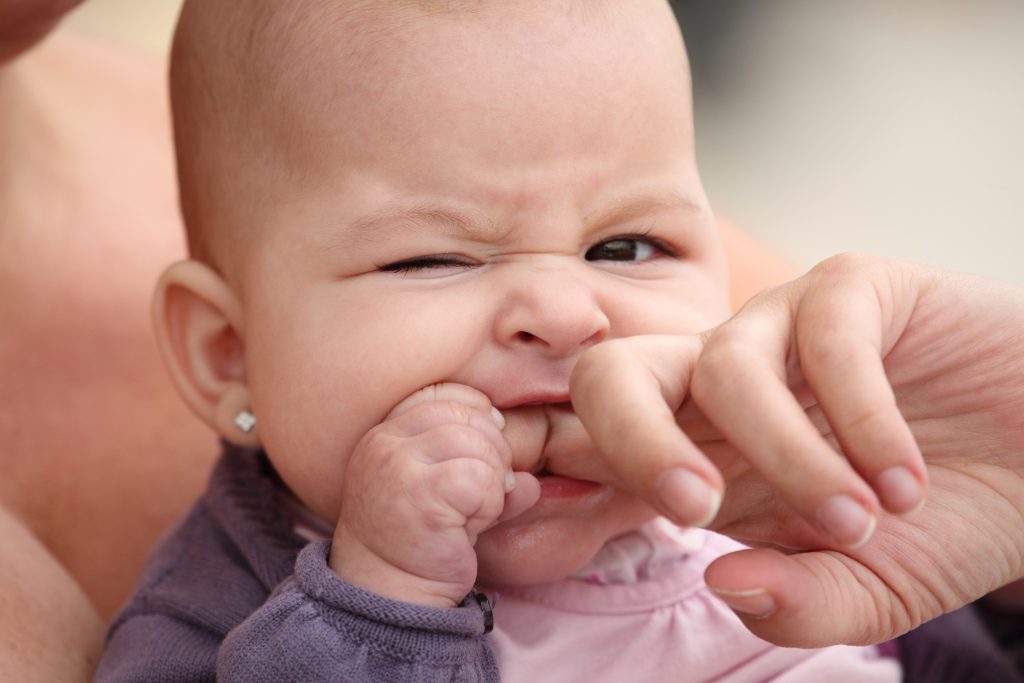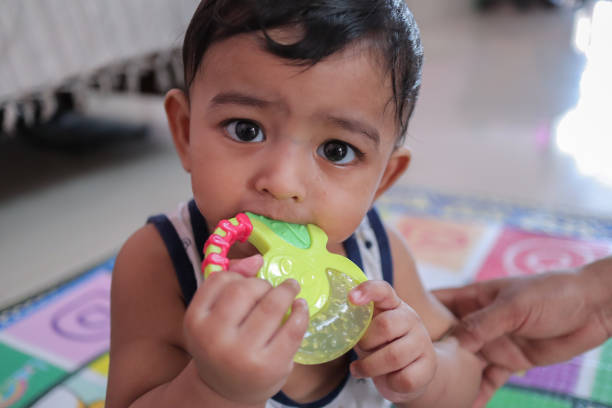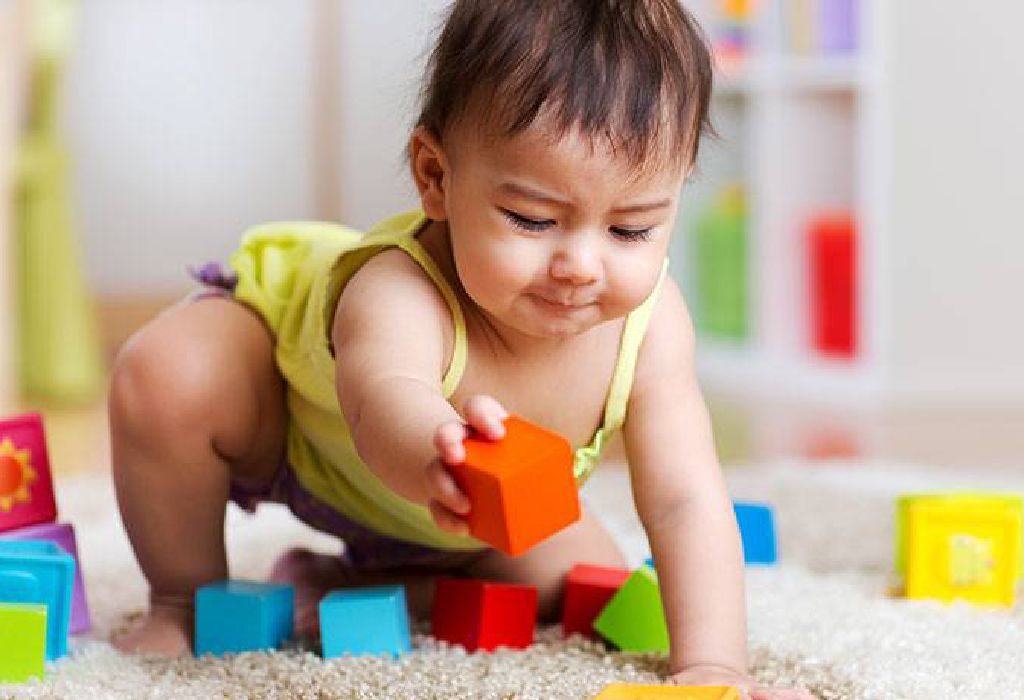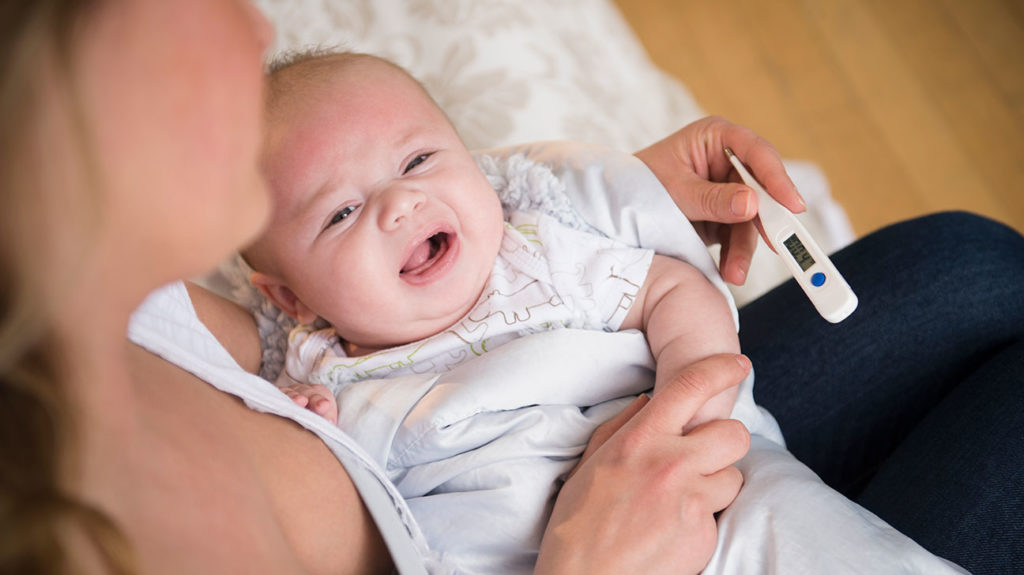Babies are born with 20 primary teeth that are hiding inside their gums. And over the next two and a half to three years, those teeth are going to erupt and break through those gums. And this process is what we know as teething. Now, the good news is the discomfort a little one experiences from teething should technically only start a few days before that tooth breaks through and stop a few days afterwards. The not so good news is that your baby is going to go through this process 20 times. What are the teething symptoms? What are not the teething symptoms? I will introduce the strategies to help you relieve some of the discomfort your little one’s going to experience.

Teething can begin as early as three months of age, but you’re more likely to see your baby’s first tooth anywhere from four to seven months of age, or in extremely rare cases, your baby might’ve been born with a tooth or have a tooth arrive in the first few weeks of life. The first two teeth you’re most likely to see are the center two bottom teeth. And then there’s a set sequence that the teeth typically arrive in, but it’s not uncommon for babies teeth to arrive out of sequence. No matter what order those teeth arrive, your baby will have 20 teeth by their third birthday. So they’ll have 10 teeth on the bottom jaw and 10 teeth on the top jaw.
Teething Symptoms
Now you might have a baby who doesn’t show you any signs at all that they are teething, and those teeth just arrive. Or you have a little one who has all the teething signs.
So one of the first things you might notice is an eruption cyst, and that is a blue or gray bubble on your baby’s gum which would disappear when that tooth comes through.
Your baby might also have gum pain. That’s the pain at the side where that tooth is going to come through, sometimes, it will result in a baby being more fussy and changing their diets. They prefer to have a kind of pureed food or softer food because the harder food is causing them more discomfort. And of course their sleep might be interrupted because of that gum pain.
You might also notice that your baby has an increased craving to chew on absolutely everything. So there might be your toy fingers or anything else that they can find around the house. Now, with this chewing, you will notice an increase in dribbling and drooling. Now the key word here is an increase in this behavior, not the start of dribbling and drooling which generally happens at around eight to 12 weeks of age, which is when your baby first starts to make saliva. So this is a sign itself that they’re teething, but as a result of extra chewing on things, your baby is going to dribble more, because, unfortunately, those motor receptors in the mouth are going to send a message to the brain to say, produce more saliva. And then our little ones don’t yet have the skill to swallow that saliva, or actually manage it in their mouth. So that dribble is just going to come straight on out. Because of that extra drooling, your baby might also develop a dribble rash.

Teething does not cause a fever or diarrhea. So if your little one is experiencing any of those symptoms, it’s important to go to a doctor to have them checked.
Teething Tips and Teething Remedies
Now let’s talk about what you can do to help alleviate some of the discomfort your little one might be experiencing when teething.
So the very first thing you can do is provide a gum massage. Putting pressure on the sore gum can actually decrease the pain your little one’s experiencing. So you would obviously clean your finger and then rub that along the swollen or irritated part of your baby’s gum. And you can do this as many times as you want throughout the day. Really, it depends on how happy your little one is to let you rub their gum. If your little one isn’t that happy for you to rub their gum, don’t worry, they can actually rub their own gum, and essentially give themselves a gum massage by chewing on things. So they can chew on a pacifier or a dummy, if they’re already using it. If they’re not using it, then don’t worry about introducing it.
Or you can use a wet face washer, this face washer should be placed in the fridge after it’s been wet and chilled, and then given to your baby to munch on. Don’t put it in the freezer, because if you put it in the freezer, there’s a risk that they’ll get freezer burn when they put it in their mouth. Now you need to make it easier for your little one to actually hold the face washer. I’ve seen lots of videos where they just twist it and then wet the top part of the face washer, and place it in the fridge, and then give it to the baby. As you can see, this is a really thick handle. It would be really hard for your little one to hold. So a better option is to actually roll it up really, really tightly. And then again, only wet one end and then place that in the fridge. And then you could give that to them as a thin cylindrical item to hold, which is easier for your babies.
Or you can give them a teething ring. I prefer teething rings that are circular because it’s easier for a four to seven month old baby to hold when you’re thinking about their fine motor skills, or a teething ring that is cylindrical in nature. Now, of course, when you’re looking at buying a teething ring, you wanna make sure that they’re made from non-toxic ingredients. So that might be a hundred percent natural rubber, food-grade silicone, untreated natural hardwood or food-grade safe plastics. And if you get a teether that you can place in the fridge, even better, because then you can give it to your little one chilled. Again, remember don’t put it in the freezer because when you give it to your baby it can actually cause a little bit of frostbite. So it’s not ideal.
Your baby might also like using teething rusks or biscuits or having food that is chilled, but this is only really appropriate if your little one is eating and you need to always make sure that you’re watching your little one when they’ve got a teething rusk or biscuit. Now because your little one is going to be chewing on a lot more things, you’re going to notice that increase in dribbling which can cause a dribble rash. So you want to prevent that rash from happening by making sure that you wipe away any excess drool. And also use bibs that have a waterproof backing and apply a moisture barrier cream if needed.
The other strategy that can work really well is distraction. But this is only helpful when your baby’s awake during the day, it doesn’t help at night time. What you can do is just try and engage your baby in more play, just try to distract them from that pain.
If they continue to experience some pain and discomfort, and it’s interrupting their day and their night’s sleep, you can consider using medication to manage that pain. But that’s always something you should talk to your baby’s doctor about, because then you can find out what medication is suitable and at what level.
Things Not Recommended for Teething Relief
There are some things that are no longer recommended for helping relieve teething symptoms.
First, the teething necklaces. They are jewelry or beads that are worn around a baby’s neck or on their wrist to help relieve some of those teething pain. And it’s typically made from Amber.

The US Food and Drug Administration or FDA no longer recommend these, because it can lead to strangulation. And there is a risk of choking, if those beads break off at all.
The FDA also does not recommend the use of teething gels, because they have found that they’re not necessarily useful for babies who are teething, and in fact it could cause your baby harm. So teething gels themselves usually wash out your baby’s mouth very quickly, because they swallow it. And then as parents, we tend to put more on. And that excessive amount of medicine which they are constantly swallowing can actually be really harmful for your little one, and cause some serious health conditions. For example, benzocaine, which is a local anesthetic found in some teething gels can cause choking, bluish skin, allergic reactions and a rare but serious blood disorder.
Myths Vs Facts
Teething is something every kid will go through. As there are various myths surrounding this topic, we nail down six myths to separate fact from fiction.
-
Myth #1: My ten months old baby has no teeth. Something is wrong.
Fact: Every infant is different, and development takes place at their own pace. Your baby’s teeth will make a grin and grumpy entrance anytime between 3 and 12 months. Talk to a doctor if your baby is still toothless at 18 months. It could be a warning sign of any oral health issues and impacts speech development.
-
Myth#2: Teething causes fever.
Fact: Teething causes less than one-degree Celsius elevation in body temperature, as it does cause irritation and inflammation of the gums. Although seldom, low-grade fevers are possible the day before and after a tooth erupts. Any fever over 38 degrees Celsius warrants immediate medical attention.
-
Myth #3: Teething causes ear infections, diarrhea and other nasty symptoms.
Fact: Like fever, ear infections and diarrhea are more likely to be completely unrelated to a baby’s tooth coming through. They can be symptoms of other unrelated illnesses, which often go untreated by parents who think your baby is just teething. If your little one starts showing these symptoms, take him to the doctor.

-
Myth #4: Teething causes diaper rash.
Fact: Diaper rash is more likely caused by wet diapers, and it is often the result of either not changing as frequently as you need to, Diarrhea or even yeast infections.
-
Myth #5: Teething babies need medication.
Fact: Medication is unlikely needed for teething. If they are feeling uncomfortable. The best relief you can give your child is something to gum on, like a teething toy or cold washcloth.
-
Myth #6: Baby teeth are not that important.
Fact: Yes, your baby’s primary teeth are temporary, and will eventually fall out. However, strong baby teeth are essential for eating and speech development. Baby teeth are also essential to keep space in the jaw for adult teeth to grow properly. Teething symptoms are usually mild; your baby may experience discomfort, excess drooling, fuss over sleep or lose their appetite temporarily. Do not worry, it is part and parcel of their growing up.

